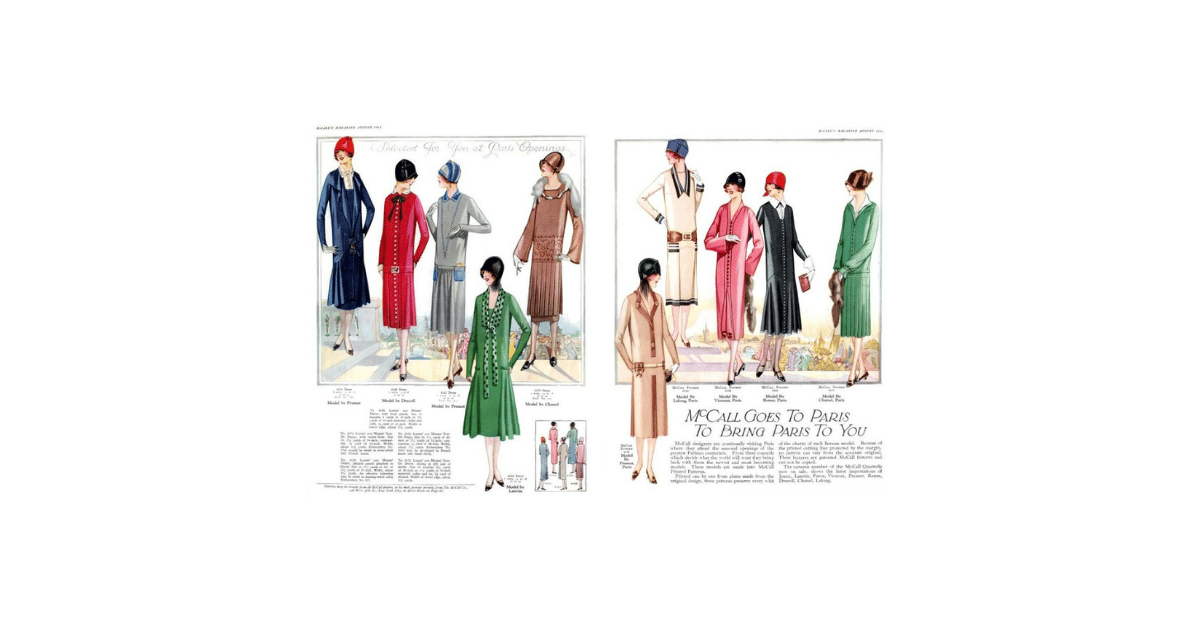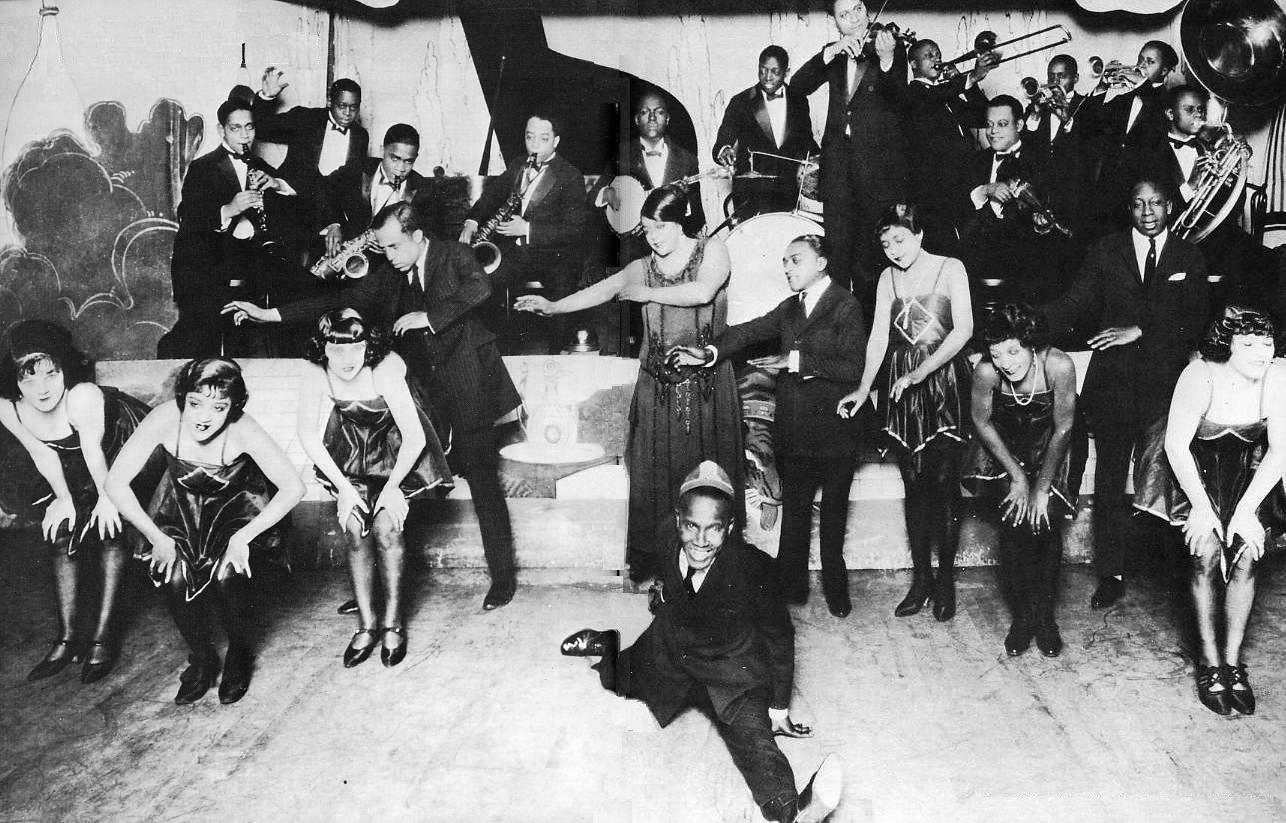1920 Wedding Dress from Old Photo
Karen Seymour recently emailed me copies of several early 1920s wedding dress and group photos in her possession, they were taken in Melbourne, Australia. Some of these old wedding photos belonged to her Great Aunt Esther Prosser who was also a bridesmaid at two weddings. However, this page shows an earlier wedding photo of 1920 that also belonged to Esther although she is not in the image. Esther who lived to be 91 will be shown in other old photos on the 1924 wedding page.
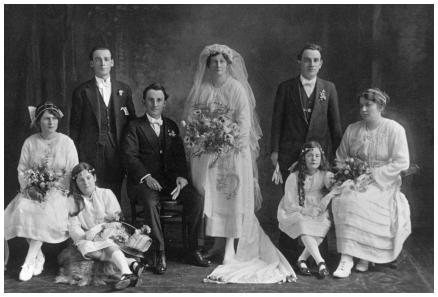
This wedding took place 2 years after the 1914-18 First World War and has a known date of July 1920. The wedding took place in Melbourne Australia and is of Clarence Dundas Seymour and Letitia Gertrude Henderson Clayton Marr.
The wedding party comprises the bride Letitia's 3 sisters, Jean, Ida and Adelaide, her brother Leslie (standing at right) and her friend Grace Perry (seated on right). The groomsman behind the bridegroom is Clarence's brother Brian.
1920 Bridal Bouquet
Note the bridal bouquet - The bouquet is interesting in that the flower styling is quite naturalistic for the era. I know little of Australian flowers, but suspect the main delicate bloom is a fragile flower. It has the appearance of a cross between a lisianthus and a pastel poppy. Somewhat unfortunately, the horseshoe carried by the bride is hanging upside down. To keep the luck forever the silver wedding horseshoe should always be carried by ribbons hung from the horseshoe shoulders. Superstition says that if hung the wrong way the marriage good luck will fall out of the wedding horseshoe.
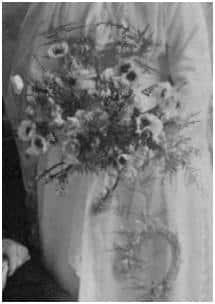
1920 Wedding Headwear
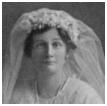
The bridal headdress Letitia wears is in keeping with styles of the late teens and 1920s. One other factor in dating old photos of this era is to look closely at the headdresses.
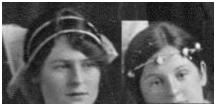
In this case the bridesmaids wear two distinctive styles of 1920s headband.
Of course the one photo most people find in old shoeboxes of photos is the wedding photo, so being able to date the bridal dress adds to you armoury of dating the image. These 1920's wedding dress styles below date from 1920 to 1923 and may also help you date an image. Note all the headdresses which all have the similar mobcap features.
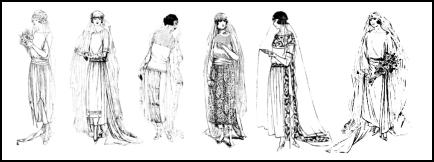
Note that the dresses are actually quite long for 1920s dresses, but that is because even day-dresses were long in the early 1920s.
The Bridal Skirt Silhouette 1920

There are several style and silhouette similarities between the shorter dresses of the bride and the Maid of Honour. The necklines and loose sleeve cut give a synergy to the bridal group. The clear visibility of the ankle on both adult women is also in keeping with silhouettes of the 1920's wedding fashion of the era.
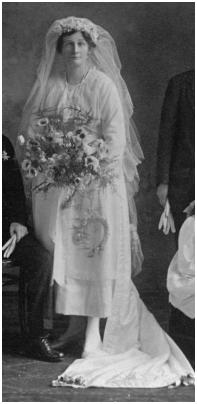
Note carefully the above ankle length of the dresses, the deep hem of the bride's wedding dress, and the deep wide tucks creating a texturally interesting border on the dress worn by the Maid of Honour.
Tucks and deep hems were sometimes joined with hemstitching, lace inserts, withdrawn threads, or picot stitches. The deep hems, contrast fabric hems and tucks are a feature of early 1920s dresses.
Multiple ways were devised to piece extra lengths of contrast fabric or lace to a lower skirt. Faggotting (shown right) between two pieces of fabric would have been a great way to introduce extra fabric length in a decorative manner.
The hemline styling is also another way of expressing mistrust of the latest fashion length. The hesitant fashionista of any era often adopts in-between safer looks, which then finds its way into mainstream fashion, such as the handkerchief hemline of the mid 1920s.

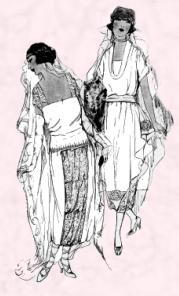
The depth of the 1920's wedding dress hem in the photograph left is such that one wonders if the wedding gown was shortened at the last minute to give it the latest stylish edge.
However, one suspects that a prudent seamstress declined to cut the vast hem away in case the dress would be used by another bride at a later date, when dresses were again floor length.
It is fair to say that after the teens the hemlines on dresses did rise and fall with regularity. The 1920 wedding dress sketches above right show how calf length gentle puffball and tiered styles were also the mode.
Everywoman's Magazine 1920
Everywoman's Magazine, a periodical of the fashion history era, featured a bridal article in the December 1920 edition. Two of the images below left and centre are taken from it. The bridal sketch far right below is also from a Good Housekeeping October 1920 magazine. These dress styles are clearly the latest fashion looks and show a narrowing and leanness to the skirt silhouette.
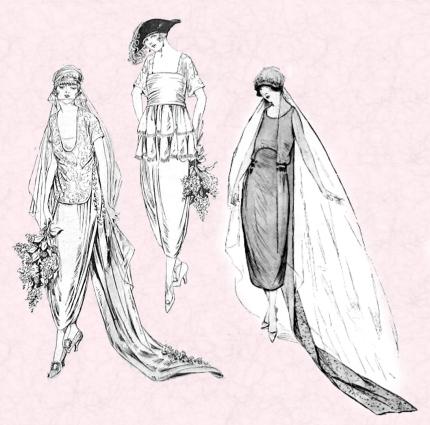
Everywoman's also commented on the wearing of 'Bridal White' compared to choosing a light bright colour and stated :-
BRIDAL WHITE
"A white dress for the bride is more or less traditional, and it is very infrequent that one has the courage to break away from the custom. However a Society bride of a few weeks back was venturesome enough to go to the alter in peacock blue. The dress was designed on the usual stately lines that wedding gowns follow, and had a magnificent train of cloth of silver lined with blue ninon. Silver leaves held the bridal veil of blue tulle. It was a startling innovation and I must confess that the result was extraordinarily effective."
Women were also given advice on the Trousseau and especially on the correct suits, collared coats and dresses for every possible occasion. This suit, coat and three dresses below were typical of trousseau wear, and were taken from December 1920 Everywoman's magazine.
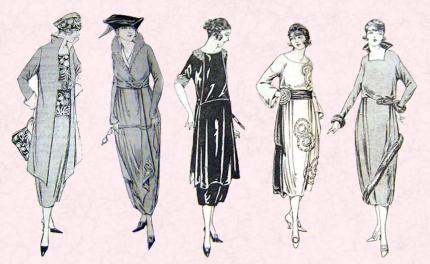
Elements found within everyday dress styles can be an important indicator of the date of an image. Using female dress as the guide is often the fastest way to date an image since male dress often seems to move more slowly especially a hundred years ago.
Old family photos are often a total mystery to those who end up owning them. So it is well worth making records of the identification of people in images before all relatives pass away. Older siblings may be more knowledgeable than younger siblings, so when you have the opportunity to see relatives, ask about old pictures, and make notes of names and dates on the back of those old photos.
Consider making a CD of all your family photos and enclosing them with birthday or Christmas cards. In an era when many of us live in affluent countries, such a thoughtful item can bring enormous pleasure in a way that expensive gifts cannot. We all need to know our roots and genealogy can be a fascinating hobby.
1920 Facts and Events
- On April 3, 1920 F. Scott Fitzgerald married Zelda Sayre.
- Clara Bow the 20s film star and Gilbert Roland were romantically linked, but their relationship did not blossom into marriage.
- One novel wedding invitations idea, was to print the cards in the shape of a 33 gramophone record; the phonograph having just become the must-have item.
- Large wedding bouquets were in fashion, with orchids, gardenias, lilies and maybe even ostrich feathers being popular.
- Life expectancy was only 55 back then in the 1920s.
You can read more about 1920's fashions in flapper fashion. You can read how to date an old photo in this section here. These wedding photos must not be published/used elsewhere - © Copyright www.fashion-era.com 2022 Page added 20 November 2009. Ref P.751.
These wedding photos must not be published or used elsewhere - © Copyright
Old photos can be useful when tracing family members and narrowing down search dates. These photo pages may help you put an era to your undated images. If you have old wedding photos please send them to me and if suitable I will add them to this pictorial section of social history.
1921 Old Wedding Photo
This family wedding photo is of an ordinary couple. Nevertheless the pictures reveal a treasure trove of features typical of the fashion of the early 1920s.
- 1920s Wedding Photo of Large Group - The Bridal Party 1921
- 1921 Wedding Shoes
- 1921 Group Wedding
- Grace Roberts and Joseph Brittain in Walthamstow
- 1923 Group Photo
- 1921 Double Wedding in Hebburn
- 1921 Facts and Events
1921 Old Wedding Photo of the Bridal Couple
Vera's parents were married just 3 years after the Great War of 1914-18. This was an era of a society moving forward, breaking new barriers all combined with a society on the verge of an economic depression as Britain tried to rebuild itself whilst still paying for the war costs.
Many men had been lost during the war and as a result, many women lost loved ones. These women did not even have a grave to visit as many men were buried in unmarked graves. Vera's parents had to endure long months apart even though the war had ended. Relations between European countries were still fragile and men were still employed by the services.
Vera wrote: 'My Dad was in the Royal Canadian Navy (Petty Officer) and due to be away for 20 months. I know he went to Esquimalt, a remote part of Canada, but more importantly my mum was devastated to think of a whole 20 months without him. Such a short time in the scheme of things, but such a long separation for a new bride.'
The wedding dress is worthy of note. At the time dress lengths were fluctuating. The deep tucks, whilst acceptable decoration for the era, may indicate that dress was worn by another bride a few years earlier and then altered to bring the dress into line with shorter hem lengths.
1921 Wedding Shoes
Take a good look at those lovely wedding shoes. It is just possible to make out the decorative motif on the uppers.
1920s Wedding Photo of Large Group - The Bridal Party 1921
This wedding group photo is a reflection of the social conditions of the era. Everyone is quite well dressed and the event was deemed worth recording, but the surroundings are make-do. This is someone's backyard. Perhaps it was the photographer's backyard which was out of necessity used for larger group photos.
I have examined several other images of this era which seem to have been taken in the yard of a photographer. Maybe the photographers were just starting out, or perhaps they mainly shot portraits which don't demand much room.
However, it could have been the family's own yard. Observe the bicycle wheel sticking out at the photo left.
Notice also the back door to the right and the corrugated sheets of iron on both sides. The latter product was used for farm buildings and also as a temporary building material.
Considerable effort has gone into arranging the group for this old photo. The children sit on a mat or rug to protect their clothes from the rough and dirty surface. The bridal group are seated and that enables the rest of the guests to be seen clearly. Look closely at the flowers that many of the female guests are holding. I think they may have come from a keen gardener in the family. No two bunches are the same and the flowers seem to be an expression of fondness, a personal gift for the recipients in the way that wedding favours are used today.
The women at the left of the photo wear what were commonly referred to in the early part of the C20th as 'waists'. A new waist could be teamed with an existing skirt for an up-to-date look. A wedding would have also been an opportunity to buy a new skirt!
High waists like these had been a feature of fashions between 1916 and 1918, but as always, there is an overlap in fashion styles in the history of the era. The woman holding a baby in the picture above right, is clearly wearing a newer style of dropped waist dress fashion.
Later on, in the fifties, the 'waist' was a garment mostly known as a shirtwaister. Today we would call the item a top or smart blouse, or simply a shirt.
The women also wear fashionable hats of the early 1920s.

Brimmed felts look especially popular, although two very modern hats circa 1920 are shown far left. The younger girls wear tam o'shanters.
1921 Group Wedding Grace Roberts and Joseph Brittain in Walthamstow
This old wedding photo was taken on June 11th, 1921 in Walthamstow England. It is of Grace Roberts the bride and the groom, Joseph Brittain. The father of the bride who is sitting far right - is the same as the one as the father in the 1925 wedding page, but of course this is four years earlier. His wife Florence sits beside him. The bridesmaid to the right of the bride is Winnie, the bride in the 1925 old wedding photo page.
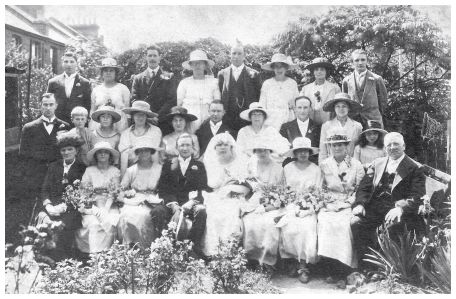
This image is not so clear as some. Indeed inspection of the original suggests that they may well have had to be still for a few minutes. But it does show a lovely array of summer hats and these fashion clothes worn still have a slight look of an earlier fashion era. Despite the fact that it was taken in 1921 it is clear that the 1920s as we think of them had not taken hold.
Jan the sender and I were both struck by the small number of men in the picture, perhaps due to the losses of the Great War discussed above. Jan believes the photo was taken in the back garden of their house.
1923 Group Photo
Below is a fashion history picture of note in that the younger the women, the shorter the length of their dress or skirt. In this 1920s era, skirt lengths reached their ultimate shortness between 1926 and 1927.
Back gardens are often popular places for large groups to have their photograph taken. Vera told me that this old photo was taken in 1923. Incidentally, Vera's parents own wedding in 1921 was shown in the at the top of the page.
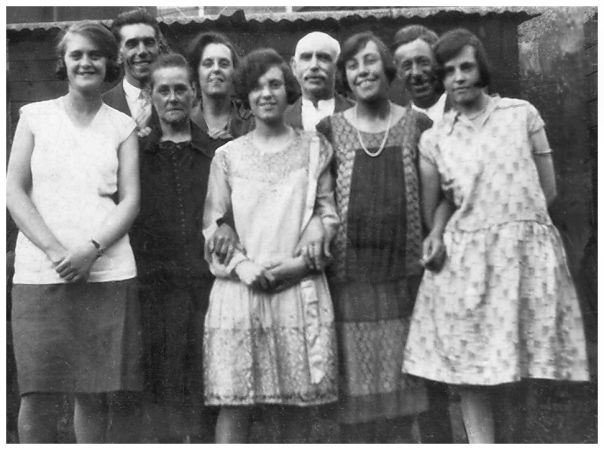
The central character in this photo above appears to be wearing a lace embellished dress with rather thick double satin streamer ribbon. If you enlarge this picture you can see that the streamer ribbon is of Luxe quality.
We ponder when this group picture was taken in relation to the wedding; was it some time after the wedding, or perhaps just before the big event.
Vera also wrote ' ....There was a double wedding in the family a few years later....'
Below this section is an old photo of a real double wedding, but which has no connection to Vera's relatives above.
The Changes in Weddings
You may well wonder, who today chooses to have a double wedding? Well usually those with a non-inflated ego, or those who are interested in having a lavish affair, but who by joining forces with a second couple can easily reduce costs. Perhaps the brides are sisters.
The advantages of a double wedding are enormous in cutting costs, since the reception/venue hire is all only paid for once. Guests only need to buy one outfit. The double event also makes it worthwhile for guests who need to travel from afar to attend a momentous and memorable occasion. However they still need to buy two presents - one for each couple.
Nowadays most brides think of themselves as the centre of attraction for the wedding day. Few would consider sharing what has become such a big 'look at me, I am a celebrity for a day' event. In the celebrity obsessed culture of today, 'me-me' wedding events are far more usual than shared ceremonies. What with hen parties turning into spa weekends of three or four days, and wedding locations being held in exotic venues, or exclusive faraway costly locations, the average guest, especially the single old friend, feels the pinch.
Many guests today tell of their irritation at having to pay for excessive accommodation and flight bills just to attend weddings in exotic locations abroad. To this they add how disgruntled they feel that apart from the loss of holiday leave, they are obliged to top up the wedding weekend into five or seven days to make all the effort, arrangements and cost worthwhile.
One person told me that for the last three years she had been all but forced to arrange her holidays around the weddings of friends. The aspect that annoyed her most, was that others (the bride and groom) were in effect choosing her holiday destinations, and often in peak season when flights and single rooms were at a premium. Two must-attend weddings in one year easily meant that her work leave and holiday budget were soon used.
Perhaps double weddings were more usual in the 1920s. Certainly they have been popular in the past when it was considered a joyful event for twins or sisters to marry, and for parents paying for a wedding to be able to provide for a more lavish event. Whether or not double weddings will ever be all the rage again, is another matter.
A 1921 Double Wedding in Hebburn
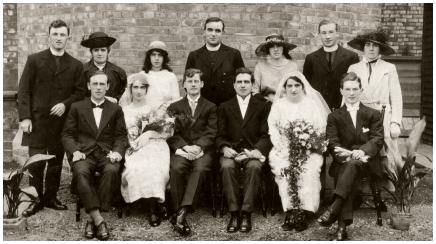
I have many photographs on this website which have originated from a colleague in Hebburn. This particular vintage wedding photo was sent to me by site visitor Patrick.
The double marriage ceremony took place on 21st June 1921 at St Aloysius' RC Church, Hebburn on Tyne, North of England. The persons shown include :-
Front row centre left - Margaret Laydon, the first bride with her bridegroom James Aspinwall M.M. Next to him in formal dress is the second bridegroom Patrick Thomas Rowan, who married bride Maria Laydon far right.
One thing that fascinates me about this 1921 Hebburn wedding is the dark colour of the footwear that both brides wear. Flesh coloured stockings were fashionable from 1921-22, but may have been initially considered risqué in some circles.
I think here it implies a measure of frugality and the wedding was a stretch on their resources. White shoes are not very practical in any era, and especially 90 years ago, when travel was often by foot. The brides' dark footwear was practical and must have been worn time and again after the special event.
Briefly, I can relate that what started as a happy double wedding day, became two contrasting life stories. Margaret and James, on the left as we look at the picture, were both colleague schoolteachers. James won a Military Medal in WWI for shooting down an enemy German plane. Later he became a headmaster living to be more than 100 years old. They had seven children.
By contrast, the centre right bridal couple Maria and Patrick Rowan, three children, but a relatively short marriage. Patrick had worked as a shipyard boiler maker, but was also an accomplished piano teacher/accompanist. In the Great Depression, in 1929 he travelled to the USA where he sought work. But there he was diagnosed with cancer, and unwell, he returned to UK and died in 1931 at Hebburn, he was just 36 years old.
1921 Facts and Events
- Post World War I unemployment reaches 2 million in Britain
- Marie Stopes opens the first birth control clinic in London.
- 1921 Coco Chanel introduced the world to the perfume Chanel No.5.
- Novelist Edith Wharton becomes the first woman novelist to win a Pulitzer Prize for her book 'The Age of Innocence.'
- 1921 Albert Einstein wins Nobel prize for physics - 'for his services to Theoretical Physics, and especially for his discovery of the law of the photoelectric effect' or the theory of relativity = mc2.
- Russia is swept with famine and Lenin asks the world for help.
- Adolph Hitler becomes the leader of the National Socialist German Workers Party also known as the Nazis.
- Prince Hirohito was appointed Regent of Japan
- The first helicopter flight is made by French Aviator Etienne Oehmichen.
- Britain recognised Ireland’s independence as the Irish Free State when they jointly signed The Anglo-Irish Treaty in December 1921. An Irish Free State and Northern Ireland are created giving jurisdiction over twenty-six of the country’s thirty-two counties.
These wedding photos must not be published/used elsewhere - © Copyright www.fashion-era.com 2022
Page added 10 October 2006. Updated March 2008.
These wedding photos must not be published or used elsewhere - © Copyright
1922 Wedding Photo of Bride Evelyn Griffith
Right - is an old 1922 wedding dress photo of a bride called Evelyn Griffith.
She was married on September 30 1922 in CA, America. The fashion-era visitor Anne Scott, who sent this picture, has several old photos of women possibly wearing bridal dress.
But unless the bride is obviously in a bridal gown as in the case of Evelyn right, then it can be hard to decipher if a dress is just an evening gown.
Even a floral corsage does not prove the dress is a gown, since many women wore fresh flowers given to them by their partner to a ball. However, a big plus in this 1922 wedding photo is the wedding veil and headdress.
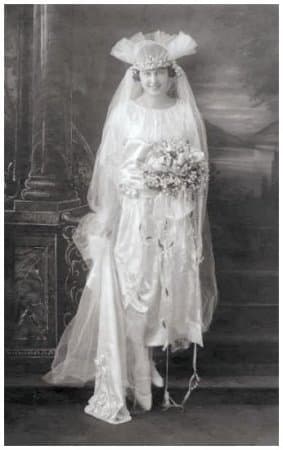
One thing I have noticed in 1920s wedding photographs, which are known to be of American origin, is that long ribbon streamers intertwined with leaves or buds are a usual styling of the bouquet. Therefore if you have a photo, the volume of ribbon streamers is an indication that a wedding took place in USA rather than UK/Europe.
1920s Style Wedding Dress & Veil
In the early twenties, the style of all dresses, not just wedding gowns was changing. Dresses were soft and relaxed, but were still mid-calf length for most women. Notice how similar the line of Evelyn's wedding dress is to the scallop hem day dress below. You can see more scallop hem dresses on this page for dating old 1926 wedding photos.
Evelyn's train is crunchy with texture. Just look at those raised floral forms that decorate the edge of the train. Her shoes are a variation of the Mary Jane style.
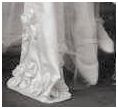

Evelyn's headdress is very interesting and has a new look compared to the usual dull cloche styles of the 1920s fashion era.
The tiara very much follows the line of decorative trims also seen on hats of the twenties.
The bridal tulle headdress above has developed a pie-crust fan edge which gives an upward tilt to the face. This style must have been welcome for many brides, who for more than a decade had little choice but to follow the prevailing cloche veil fashion.
The cloche veil dragged the hair flat and left the face devoid of uplift for the majority of brides.
You are reading an original independent '1922 wedding photograph' article by Pauline Weston Thomas at www.fashion-era.com ©
Some Dress Silhouettes of 1922
The three fashionable 1922 styles from La Mode magazine and shown right, all have a slightly dropped waist and easy full skirts. Two of the real 'wedding' dresses have a wide boat neckline and short sleeves.
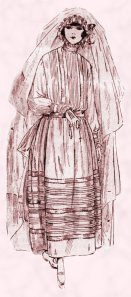
Since it was clear skirts lengths were dithering, tucks, handkerchief hemlines, extra hemline frills and contrast bands of fabric were a popular fashion hemline option.
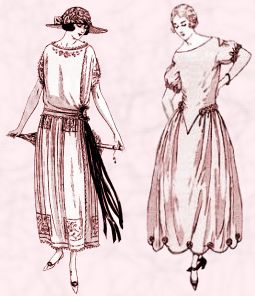
The third dress far right above, has a scallop hemline and this was employed greatly in 1926 when hemlines rose dramatically. Even so take care to observe how long these dress sketch styles really are for dresses of 1922. Only the ankle is visible.
First Communion Dress 1922
The first dress sketch near left, echoes styles of bygone days and the Edwardian high dog collar neck. At first glance this gown might be mistaken for a wedding dress. This tucked dress appeared as a dress pattern in la Mode in 1922 and is probably a first communion dress rather than a bridal gown.
Juliana wrote to me 'French first communion dresses of the 1920's somewhat resembled contemporary wedding dresses, but were plainer and considerably more conservative in cut, thus the high neck and long sleeves.
The tucked skirt was also very common on French first communion dresses from the 1900s into the 1950s. Long sleeves seem to have been still fairly common on wedding dresses of the early 20s, but the high neck would be unusual. Note the rosary the girl holds.'
So this first dress is possibly not a true wedding look of 1922 and I draw your attention to it, as it is so easy to mistake it for a wedding gown style.
It certainly had me confused until the website visitor pointed out the differences.
1920s Lace Border Hem Wedding Dress Unknown Date
The styles here are all similar in outline to this black fashion silhouette shown right and from my 1920s silhouettes section.
The twenties lace border hem bridal gown shown left is from an unknown old twenties wedding photograph and was provided to me by vintage USA eBay seller manaseri2007. The bride is stunning.
Her silhouette is so like the black silhouette right.


Immediately see how similar the silhouette the Lace Hem dress is to the Evelyn wedding dress/headdress discussed above and shown left.
In deciding where the wedding took place, with all that trailing ribbon to the bouquet, it's easy to deduce this is an American wedding.
The piecrust fan headdress and veil is more than likely the same year as Evelyn's wedding attire. It is barely noticeable, but Evelyn's dress is very slightly shorter than the unknown Lace Hem dress left. Both dresses have scoop rounded necklines and both are very dropped-waisted.
The lace insertion at the dropped waistline is delicate and reminiscent of the fine whitework dresses worn by Edwardians. The shoes follow the T-bar style.

I would surmise though that this wedding (left) took place in the early months of 1922 since the bride wears a jacket over her gown. Evelyn's wedding (right) took place in the autumn, in September.

Even giving a little room for error, I would not date this old wedding photograph left later than 1924. The styling of the dress is also very much in line with the 1922 Royal Wedding and slightly longer lengths shown below.
You are reading an original independent 'old wedding photograph' article by Pauline Weston Thomas at www.fashion-era.com ©
1922 Royal Wedding Dress - 1922 Old Wedding Photograph of Princess Mary of England to Viscount Lascelles
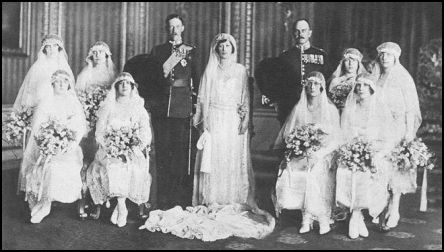
On Feb 28 1922 the wedding of Princess Mary of England to Viscount Lascelles took place in Westminster Abbey, London, England.
Queen Mary, King George and the dowager Queen Alexandra were all in attendance. In this 1922 royal wedding photo are; the bride Princess Mary of England, the groom Viscount Lascelles, plus their attendant bridesmaids. The wedding photograph was taken in Buckingham Palace. The lace wedding dress of Princess Mary follows the straight lines of the day.
Her attendants all wear cloche veils as headdresses. Key - Standing from left to right, Lady Doris Gordon-Lenox, Lady Elizabeth Bowes-Lyon, the groom Viscount Lascelles and the bride Princess Mary of England, Major Sir Victor McKenzie, Lady Dina Bridgman and Lady May Cambridge. Sitting from left to right, Lady Mary Cambridge, Princess Maud, Lady Rachel Cavendish and Lady Mary Thynne.
The wedding of one of the bridesmaids, Lady Elizabeth Bowes-Lyon, which followed the next year is also featured on fashion-era. Lady Elizabeth Bowes-Lyon, later became the Queen Elizabeth consort of George VI. Her daughter became Queen Elizabeth; read about Queen Elizabeth's royal wedding in 1947.
Other Celebrity Weddings in 1922
- James Cagney and Frances 'Billie' Vernon
- Louis 'Dickie' Mountbatten and Edwina Ashley
- Kaiser Wilhelm II and Hermine Reuss-Greiz
You have been reading an original independent 'old wedding photograph' article by Pauline Weston Thomas at www.fashion-era.com © This fashion-era page has been about old wedding photographs of brides, bridesmaids and their wedding attire in 1922. These wedding photos must not be published/used elsewhere - © Copyright www.fashion-era.com 2008 You can read more about 1900's fashions in the Edwardian section. Page added 10 April 2008. Ref P.680.
These wedding photos must not be published or used elsewhere - © Copyright
1925 Bridal Dress
This wonderful old wedding photograph of a bride and her father approaching the church, was taken in 1925. The bride is the grandma of Jan, who is a regular site visitor to this website.
The wedding took place on what was clearly a bright sunny day on August 1st, 1925. The lovely bride, shown left, is Winifred Roberts (born on November 4th 1900) and her father Gregory Roberts (born October 16th, 1862) of Walthamstow, Essex (now London E17).
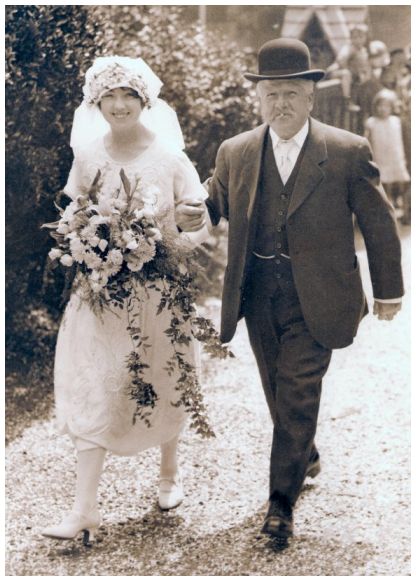
Read below a little more of what Jan wrote to me about the photo.
1920s Seated Bridal Couples
Jan wrote
'I am now sending a photograph from my grandma's wedding. The photograph shows her with her father walking into the church.
I have noticed a tendency for 1920s wedding photographs to be taken with the bride and groom sitting down. Have you noticed that? '
Indeed I have noticed this point about seated bridal groups.
If you have an undated wedding photo that looks post Victorian and the bridal party is sat down, it may indicate that the image is of the 1920s/1930s. The 1920s in particular seemed to be a fashion era when the bridal couple or party were seated for their wedding photos.
Jan continued 'This does not show the bride and groom, however, this is the bride and her father striding to the church with good humour and high spirits... and, apparently, a dog-end!'
Yes, just look at that dog-end between his lips.
No politically correct woman in the 21st century would allow her father to escort her smoking! Today he would be given strict instructions on his behaviour for the big event, by both daughter and mother of the bride.
But in those days women 'knew their place' and maybe this is an example of what is etiquette to one generation, is not considered good manners to another generation. This truly looks like a joyful event, let's get on with it happy wedding day.
Mary Jane Wedding Shoes of 1925
Take a look at those wonderful Mary Jane bar shoes. Mary Jane's have come back into fashion and you can see modern versions of the shoes here on my fashion trends pages.
1925 Wedding Headdress
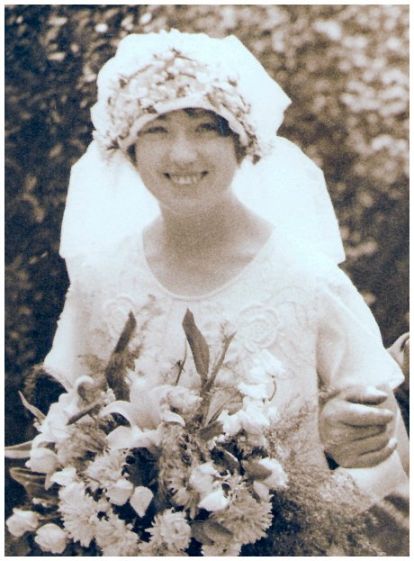
The headdress is typical of the 1920s era, actually, this style had been fashionable since about 1910. This headdress (above) almost appears to be a flower-bud foundation hat, but with a veil attached.
As the 1920s progressed, the mob cap of the bridal headdress began to be more and more embellished.
Eventually the bride's headdress took on a more medieval appearance looking much like a broad deep tiara. This change of style may be related to the influence of the traditional headdresses shown in posters by the Czech artist Alfons Mucha.
You are reading an original independent 'old wedding photograph' article by Pauline Weston Thomas at www.fashion-era.com ©
The 1925 Wedding Dress Embroidery
You may already have noticed that wonderful, well balanced, embroidery design that meanders and scrolls over the wedding gown from bodice to skirt. See also how the rose design is repeated in a symmetrical manner on the upper bodice of the wedding gown.
The organic design focuses on a central rose, and makes a play of scale with smaller and larger trailing leaves. This gives contrast between the ethereal light stitches adding intricacy, and the rich weight of heavier embroidery design work. The roses appear to have been worked in a raised satin stitch.
This bridal gown of 1925 was obviously worked with love and with great skill.
Jan explained
'The dress was probably made by the family: grandma was the youngest of five. She and her three sisters all sewed and embroidered for a living. Winnie married Albert Jeffryes and they continued to live in Walthamstow, until 1961.
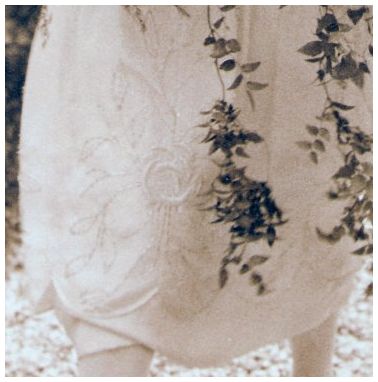
1925 Wedding Dress Double Skirt
I find skirts of this era often interesting and this wedding dress captures the dithering hemline of the 1920s. Skirts were obviously getting shorter.
But huge departures from a particular skirt length and style always takes time for mass approval. Many women would have played safe and opted for the illusion of a shorter dress. This underskirt may also have been longer and the final under length selected at the last moment.
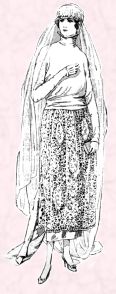
A year later, in 1926, skirt hemlines shot up and clothes have decidedly C20th fashion look. Double layer skirts, deep banded contrast hems and handkerchief hemlines are all part of such indecisiveness of design.
The top layer of this 'new shorter' double wedding skirt has a lovely scallop edge and I think I can see some seed pearls or glass bugle beads twinkling.
1920s Wedding Dress Comparison: 1925 Wedding Dress Compared with 1921 Wedding Dress
The double skirt was not a new style and had been in fashion since around 1912, indeed, the waist had moved up and down several times. This image left is of a bridal dress pattern of 1921 and you can see how the style elements are similar to those of the bride above.
If you are researching family genealogy and think the names here are related to you, then you may contact Jan via her website here.
Old photos can be useful when tracing family members and narrowing down search up-to-dates. These 1925 photos may help you put an era to your un-to-dated images.
World Events in 1925
This was the era of film stars such as Charlie Chaplin and Rudolph Valentino. While they were 'walking out' with starlet such as Louise Brooks and Pola Negri, there were no major film star nuptials in 1925.
Interestingly, Percy and Florence Arrowsmith were married in 1925 and in 2005 they celebrated their 80th Wedding Anniversary.
Other events of 1925 include, John Logie Baird building Britain's first TV transmitter. In Egypt, the Great Sphinx of Giza is unearthed and restored.
1926 Wedding Photos of Real People
- Dating Old Photos
- Charles and Ella Old Wedding Photo 1926
- Shorter Dresses for 1926 - Scallop Hemlines
- The American Dream Via Ellis Island
- Ellis Island
- 1926/7 Informal Wedding
- Cloche Hats 1926 - 1929
- Wedding of Norman Shaw & Mary Anderson 1926
- Hebburn Old School Photo of Girls of 1905
- Lottie Anderson and Sunday School Children 1918
- 1926 Some Facts
Dating Old Photos
So many people searching their family genealogy come to the art of dating photos through fashion history. Here below is an old photo of a woman who entered the USA via Ellis Island as a child in 1904.
When dating old photos, always try to compare your photo with a dated image. Fashion plates and magazines of the era are great sources to research features of your photograph. Begin with a fifty year time-span such as pre 1950, post 1950 or pre 1900. With a little web browsing it should be possible to narrow the date to a decade either side of the image date.
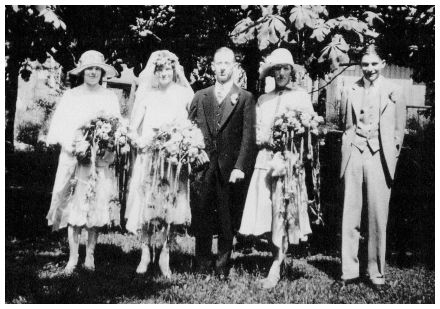
By applying techniques that I will explain, you should be able to date your old picture to within 5 years. By combining fashion features you can narrow the date to within a year or two. If you have a distinctively dressed woman you may be very lucky and hit the exact year.
Examine costume, footwear, hats, hairstyles, jewellery, decor, posture and any transport. Compare your photo with comparative images of a known date to arrive at a year for that old photo.
Charles & Ella Wedding 1926
This family wedding photo right was sent by a site visitor from the USA. The old wedding photo is of Ella Simister and Charles White and their marriage took place in the USA on June 9, 1926.
There are differences in the bouquet styles in this old photo above and the wedding group photo shown below. In this wedding party the bouquets have ribbon streamers, which makes them seem larger than the sprays really were.
Even though make up was worn in this era, these women all look as if they wear very little extra cosmetic enhancement. The bride's hair looks very natural and almost unruly.
The 1926 wedding dress above was the latest shorter length and the length most associated with our mental perception of the 1920s.
Shorter Wedding Dresses for 1926 - Scallop Hemlines & Double Layer Skirts
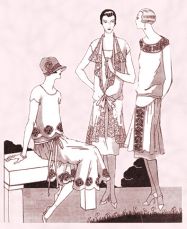
Dating an old photo of the 1920s should be straightforward, once you know what you are looking for, since the hemlines seemed to change each year in the twenties.
The three wedding dresses on this page all feature rounded scallop hemlines. Scallops were in vogue through the twenties, since they are a natural edge finish for lace. But, it's clear that one of the main trends of 1926 was not just shorter dresses, but dresses with scallop hem finishes.
The illustration left, shows how shaped scallop hemlines could be used as a feature on both the skirt and the loose overblouse bodice top.
Fluted double layers cut from soft fabrics were used to add lightness to skirts. Crossway bias and floating fabrics were another feature of this 1920s era.
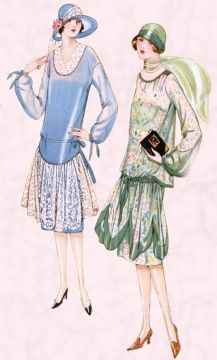
Sleeves were bloused with soft fullness at the wrist line which drew attention to 1920s manicures. This was in contrast to an otherwise boyish silhouette from head to hipline.
By 1926, shorter dresses were very much the fashionable norm for younger and older women. The double layer skirt, and scallop hemline were both ways of creating the optical illusion of the skirt length appearing shorter than it really was.
Scallops can easily be made by home dressmakers simply by drawing a portion of even circles with a cup, wine glass or saucer and then either facing them with fabric, making a narrow rolled hem, or embroidering the edge. They could also be bound with contrast fabric as shown in the McCall's dressmaking pattern green dress right.
These pretty colourful dresses from McCall's summer 1926 catalogue of dressmaking patterns show the same styling and hat accessorizing as the bridesmaid's dresses in the two bridal group old photos here. You have been reading an original independent 'old 1926 wedding photograph' article by Pauline Weston Thomas at www.fashion-era.com ©
The American Dream Via Ellis Island
Ella, the bride above, travelled to America with her mother when just a toddler.
Joan Gillard wrote to tell me about this couple and their change of lifestyle:-
'Ella’s grandparents William & Eleanor Astin were very well to do farmers in Shropshire, Great Britain. The events below all occurred around the area of Market Drayton, England, until they moved to the USA. Their daughter Matilda Astin (born 1845) married William Swan Meakin (born 1846) in Nov 1968. Matilda and William Swan attended the same boarding school in 1951.
Ella’s Grandma Clara Meakin was born Oct 1871 and her mother died before Clara was one year old. Clara Meakin married John Simister (b 1864) in Dec 1893. They were successful farmers, had 4 children (one died).
In April 1904 William Simister departed for the US via Ellis Island with a friend who told him that earning a living was easier in the USA.
Later, in October of 1904 Clara sailed to the US through Ellis Island with children, Cyril 8, Kathleen 5 and Ella 2 years 9 months to join John in New York State. They had a Meat Market and Grocery business.
They had another son named William who was born in 1909. The Simisters seemed to be successful. Clara’s half brothers and half sisters came from England to the US and arrived at John and Clara’s before finding their own homes. John died June 1955 age 91 and Clara died July 1961 age 90.
After Ella (the above bride) married, she never worked outside their home. She and Charles never had children. Charles grew up in New Jersey, USA, and had 2 sisters who were teachers. Charles worked at the Oneida Silverware factory as did numerous other Meakins when they emigrated from England.
I am not sure that they had a better life in America. They were doing so well in England......'
So many people have crossed continents seeking a better life, a bigger fortune and this family were no different. Moving on from Ellis Island and the Port of New York these people, so typical of pioneering generations before, went forward with optimism.
Ellis Island
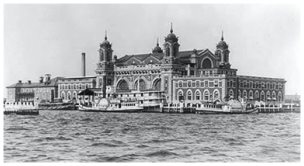
Nearly half of all Americans can trace family history to at least one family member arriving via the Ellis Island Immigration Station. Between 1892 and 1924 some 20 million people entered through Ellis Island. Over 1 million people passed through Ellis Island in 1907 the peak year of immigration.
One day in April alone 11,747 immigrants were processed. The station finally closed as an immigration clearing depot in 1954. Those unhealthy or otherwise were not allowed entry and families were often separated as some immigrants were sent back to their original country.
The American Family Immigration History Centre contains the ship passenger records of the 25 million people who passed through the Port of New York and Ellis Island from 1892-1924.
They say that at ellisislandrecords, visitors are able to access 11 fields of digitized information, as well as view and obtain reproductions of original ship manifests and photos of ships of passage, plus much more. If you are in USA and tracing family members it may be a worthwhile website to visit.
1926/7 Informal Wedding Dress

I have no firm date for the old wedding photo left a copy of which was given to me by an eBay seller of vintage collectibles and ephemera.
I would date this wedding at 1926-1928, and not earlier than 1925. The image bears a strong similarity to the wedding photo shown on the 1928 wedding page another twenties wedding, but with a known date.
In this old UK wedding photo observe how there is much more greenery in both the bridesmaids and the bride's flower sprays than in the photo above from the USA. The use and volume of flower greenery is also strikingly like that of the floral sprays in the 1928 image.
Although not a traditional wedding dress, the bride is clearly wearing quite a special dress. Take in that scallop hemline again. A close look at the old photograph shows that the lightweight narrow hemline has been rolled, just like the hand rolled edge of a good silk scarf. The darker bands going around the dress appear to be applied contrast lace.
I believe this picture was taken in the autumn winter of 1926/7 when skirts were substantially higher than in 1925. The older woman far left is wearing a coat and a fur collar or tippet, an accessory for a cooler season. It is unlikely she would have worn a fur accessory out of season. Also the long sleeved dresses of all the younger women are not pastels, but the solid colours of a colder time of year.
The ladies who sit, also have simple dresses with rounded necklines, bloused sleeves and skirts with obvious fullness. This style of dress very much fits with 1926 and early flapper style dresses. Styles of 1927 were very similar, but as 1927 progressed the silhouette was often straighter in line.
Cloche Hats 1926 - 1929
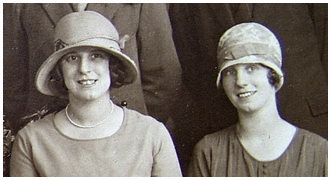
Most of the hat styles are more in tune with 1926. The far right close fitting cloche hat was especially favoured in 1927. This cloche still has a narrow remnant of a brim in line with hats of 1927.
Since 1908 some women had worn close fitting hats that clung over the brow. By World War 1 the close head fit became even snugger and the cloche hat became a firmly established headwear style.
The closer and more fitting the cloche style became the shorter the hair beneath had to be. The cloche hat was statement making and said 'new woman.' Softer variations had small brims at the front.
By 1926 so many variations of the cloche had existed that the only way to update the hat style was to reduce the brim even more. Since the cloche hat brim disappeared entirely by 1928 we can surmise this is at least late 1926, possibly 1927.
By 1929 asymmetric cloche brims reduced to nothing, although of course there are always women who wear items previously owned in the immediate years before an event. When dating any photograph always choose the woman with the most fashionable hairdo or hat and you'll have a very good photo date estimate date.
Wedding of Norman Shaw & Mary Anderson 1926
Hebburn, North England
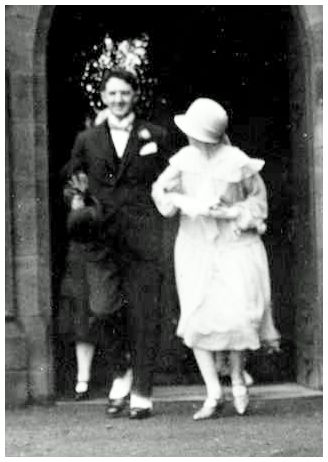
The old wedding photo right is of Norman Shaw Snr., after marrying Mary Anderson at St John’s, Hebburn, North England in 1926.
Look carefully and you will see there is also evidence of a scallop hemline in the skirt of this wedding dress too. The Mary Jane shoes in all these images though have much more pointed toes than in weddings of earlier years. In earlier years toes were rounded or squared off as seen on this 1921 weddings.
Norman the groom is wearing white spats, as is the groom in the 1926/7 wedding above. The groom looks very pleased with his decision and is firmly hanging onto his bride!
Hebburn Quay Board Old School Photo of Girls of 1905
Mary Anderson, the bride right, was born 1899 and is also shown below here aged 6 with her sister Lottie Anderson.
The old photo below is of an old Hebburn Quay School class in 1905. Notice the hair ribbon bows and several of the girls wear sweaters, cardigans or hand knits that feature bobble tie closures. Those with black hair bows may well be in mourning.
A few of the girls in this photos wear protective white cotton apron smocks that are probably covering fabrics like worsted and woollen material that was difficult to clean before the washable wools of today.
Cotton was a favourite fabric for smocks. It was relatively easy to keep clean because it could be boiled. Washing would have occurred according to a ritual pattern of the washday Monday when all whites would be boiled up in a big copper boiler, mangled then hung to dry.
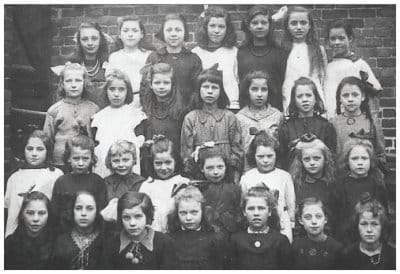
The next day or two would be spent ironing the clothes in various degrees of dampness or dryness. The small cast iron flat iron used, was heated on a stove or had hot glowing coals placed inside the base. Great care was required to stop smudges of soot appearing on the clothes. The person ironing would spit on the iron base to check the iron temperature! Sizzling meant the user was ready to iron.
Interestingly a quarter of the girls also wear necklaces, or brooch jewellery, something which probably would not be allowed in most schools today.
Schoolchildren of this era everywhere in Britain, probably looked just like this bunch of girls from Hebburn Quay Board School.
I suspect there is a difference of about 2 or even 3 years between the ages of girls shown on this photo. The girls at the back look decidedly older than the girls at the front.
At the time this photo was taken, adult women were trussed up in S-bend corsets. I doubt if any of these young girls ever imagined that as adults, they would be spared such formality and enjoy the freedom of the much looser easy 1920s dresses.
Norman wrote to me - 'I've attached a family photo for you and taken in 1918. My dads 2 older sisters are on it. Aunt Betty Dunn 2nd from left front row. Aunty Peggy Dunn 3rd from right second row from back. I have the names of most of these girls and the school was Hebburn Quay Board School.'
Many of the women in this photo were probably left as widows or single women, as the Great War of 1914-18 led to the loss of many men worldwide.

Lottie Anderson and Sunday School Children 1918
Mary Anderson, the bride above was shown in her school photo with her sister Lottie Anderson. Later Lottie Anderson was the teacher herself (right) in this wonderful old photo of St John’s Church Sunday School trip in about 1918.
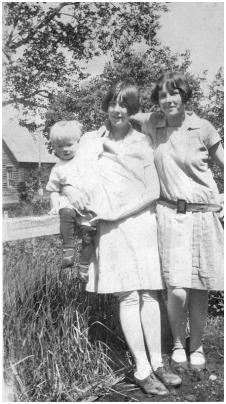
Notice how the hats the girls wear bear a helmet like resemblance to the hard hats of soldiers.
No children today would ever be allowed to ride in a vehicle with such freedom as this. Health and safety rules of the Nanny state forbid such levity!
I recall a similar day out in the early 1960s, where all the children were bundled into the back of my uncle's open lorry and we could see the road through the cracks in the wooden floorboards of the truck. It was one of the best days of my life. A happy memory to be treasured and I'd wager these girls felt just the same.
One thought - have you noticed how the girls are segregated from the boys in both old photographs further above.
Girls Dresses in 1926
Caithlin Barry, a site visitor from Nevada sent me this old photo. In the picture, Caithlin's grandmother is with her sister and the baby.
Over in USA in the same year as the Hebburn Wedding above, Caithlin's mother had her photo taken as a one year old baby. In this photo you can see a little detail of the important dropped waist and visible knees. These dresses are all relaxed and casual and yet only 20 years earlier similar young women would have been bound-up in Edwardian S-bend corsets.
Note how the stockings wrinkle at the knee, and how they both have bobbed hairstyles. Clearly, these young women were keen adoptees of modern haircuts.
If you have interesting old photos which could be included in these web pages do send me some good scans.
You have been reading an original independent 'old wedding photograph' article by Pauline Weston Thomas at www.fashion-era.com ©
1926 Some Facts
- January 26 - Television was demonstrated for the first time, by John L Baird of London.
- February 8 - Walt Disney creates his studios.
- February 16 - Suzanne Lenglen won against Helen Wills in Tennis at Cannes France.
- March 7 - The first transatlantic telephone call was made between London and New York.
- March 16 - The first fuel rocket was launched by Robert Goddard. It does 56 metres.
- April 25 - Puccini's opera Turandot was premiered in Milan.
- April 26 - A neutrality/peace treaty was signed by both Germany and Russia
- May 3 - There was a British general strike.
3 million workers went on strike to support miners. It ended mid May. - August 3 - Traffic lights were installed at London's Piccadilly Circus.
- August 5 - The first ever talkie movie Don Juan was screened at Warner Theatre, New York.
- August 5 - Houdini famously stays in a submerged coffin for 1 hr.
- September 25 - Henry Ford announced his revolutionary 8 hour, 5-day working week.
- September 29 - The actress Norma Shearer wed Irving Thalberg.
- November 19 - British mine strikes end after 28 weeks.
- December 10 - The second part of Mein Kampf by Adolf Hitler was published.
1927 Wedding Dress - Flapper Wedding Dress
- 1927 Wedding Photo of Stephen Sweder and Katherine Hoiditz
- Bridesmaids - Corsage & Headbands 1927
- Bride Photo of Katherine's Pearl Wedding Mitre Headdress 1927
- 1927 - Seated Brides of the 1920s and 1930s
- 1927 - Short Wedding Dress and Guest Dresses Photo
1927 Wedding Photo of Stephen Sweder and Katherine Hoiditz Flapper Bride and Groom Known Date 1927
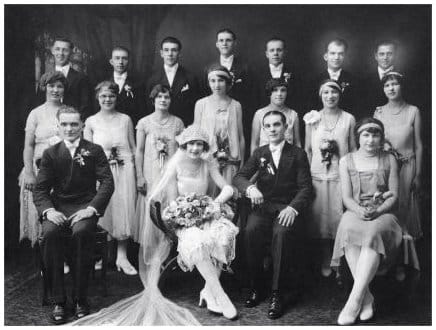
This marvellous 1920s wedding photograph, with flapper bride and bridal guests, was emailed to me by a site visitor called June and from the USA. On most pages I like to show old wedding photos from both the USA and the UK. My aim is to help visitors identify and date unknown photographs.
There are often small, but unmistakeable national differences in bridal dresses, wedding bouquet styles, bridal veils/headdresses. Americans and English even pose differently. The Sweder group is clearly very fashionable, with all the women wearing the latest flapper fashion trends of 1927.
My general advice for dating any photograph, is always look for the most fashionably dressed person for the era. These women all wear the short dress, the important fashion style of 1927. In this old photo every woman is fashionably dressed! The groom, Stephen Sweder of Russian/Ukrainian Austrian descent was born in 1906 at Mayfield, PA, USA.
Thus the bridegroom is about 20 here, and some of the men in the photo are his brothers. Take particular note of the two 'halo' male guests at either end of the back row; I enquired if they had somehow been added to the picture.
Indeed, it was confirmed that stand-ins had been used, and the two family members who were unable to attend the wedding were cleverly inserted later. Stephen's bride is Katherine Hoiditz (or Hoiditch) and she was approximately 18 when they married at St. John's Russian church.
A year after marrying they had a son. The groom sadly died in 1943, 16 years after the picture was taken. This is a very big bridal party. The older woman standing to the near left of the bride may be her mother. Several of the other women look as if they are genetically related.
The men are a handsome bunch too. They look like they all had fun.
You are reading an original independent '1927 wedding style photograph' article by Pauline Weston Thomas at www.fashion-era.com ©
1927 Bridesmaids wedding dress - Corsage & Headbands
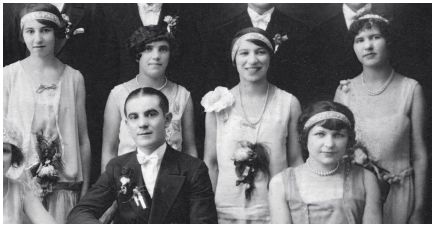
Four of the women right are clearly attendant bridesmaids, you can tell because they wear matching headbands. The woman sat at the front end wearing a contrast colour dress may have been the matron of honour as she seems to have been given a special seat, but she also wears the ornate bridal headband.
These bridal hair bands and similar brow bands, or 'drops', are back in fashion now. You can buy modern freshwater pearl versions of brow bands and lariats here from Pearlsplus. All the female guests wear flapper style dropped waist dresses and every dress is typical of the 1927 wedding styles.
Most of the women also wear pearl necklaces, and apart from the bride, each woman wears a floral corsage pinned to the front or side of her dress. None of the bridesmaids holds a floral posy, whereas the bride has a beautiful spray filled with orchids.
The fabrics in all the dresses are very characteristic of 1927, in that they float and lend themselves to circular, bias, or crosscut skirt styles.
These materials would most likely have been satin, silk georgette, chiffon and lace. Most of the dresses have a smattering of sequins, or are lifted with some minor beadwork.
Katherine Hoiditz's 1927 Photo of Pearl Mitre Headdress Bridal Veil
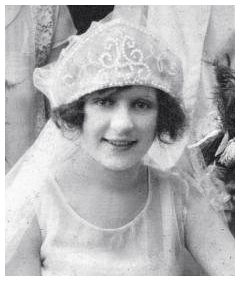
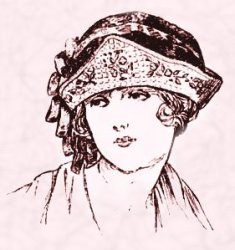
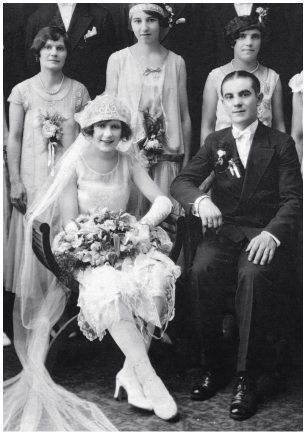
Take a closer look at the Bride Katherine's wedding headdress, it's in almost mitre style.
It follows the exact line of 1920s hats, but is made from stiffened organdie, or tulle, and is embellished with pearl beads. Every generation of brides seems to be attracted to the creamy whiteness and flattery that pearls lend to the complexion.
It is such an ornate bridal headdress that this lovely fresh young bride, obviously felt no need to decorate herself further with a necklace.
The hat picture right is from La Mode of 1921 and it's clear that early 1920 millinery design and style elements had crept into later bridal veil headdresses of 1927.
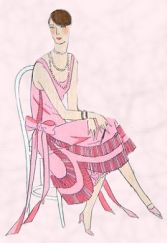
1927 - Seated Brides of the 1920s and 1930s
One thing that is noticeable in many 1930s and 1920s wedding photographs, is the number of brides and bridegrooms that sit regally, almost like king and queen, whilst surrounded by their standing guests.
The seated pose was also used a great deal in fashion plates of the era like this 1927 wedding image above right.
The seated pose also allows the bride to reveal those legs. Shorter dresses offered a new pose for photographers who made the most of capturing the image of the 'modern woman' and a skirt that rose when seated.
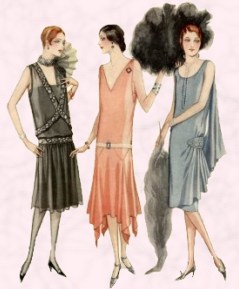
It's not hard to visualise these bright young things, the twenties flappers, having quite a knees-up after these formal photographs were taken.
You are reading an original independent 'old wedding photograph' article by Pauline Weston Thomas at www.fashion-era.com ©
1927 - Short 1920s Wedding Dress and Photo
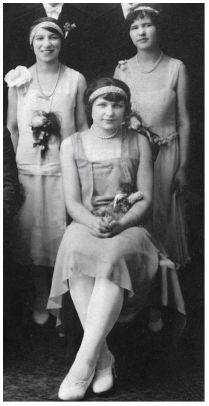
The silhouette for 1927 was straight down with the waist set low on the hipline.
Skirt lengths were short but offered room for manoeuvre for the wary, with the ever useful handkerchief hem or the scallop hemline. Necklines were boat, scooped or V shaped.
The majority of female bridal guests here wear sleeveless dresses, so one can assume this was a summertime wedding as no wraps, stoles, cardigans, shrug, furs, feathers or jackets are in evidence.
A couple of dresses have a hint of a cap sleeve, but the 1927 vogue was for sleeveless dresses such as these McCall's styles of 1927 right.
This all added to the 1920s frisson of the novel appearance of so much bare skin - bare legs (albeit in flesh tone or light stockings), bare arms and bare necklines all added to the undressed look.
Everything about the relaxed styling of the twenties bare look was in total odds to the trussed up Edwardian cinched waistlines of just 20 years earlier. The C20th was well under way, and women wanted to get as far as possible away from clothes they associated with the last century and their grandmothers.
Clearly this bridal party achieved their aim. No woman would look out of place wearing these gowns in the early 21st century.
1927 Celebrity Weddings
- Prince Amedeo Duke of Aosta married his cousin HRH Princess Anne of Orléans in Naples.
- Ernest Hemingway and Pauline Pfeiffer
1928 Wedding Dress from Thomas Paton
This vintage wedding page features four different brides. The first family wedding photo is of a bridal group who are known to have married in 1928. Play costume detective; use these 1928 wedding photos as the basis for dating your unknown wedding pictures from the 1920s era.
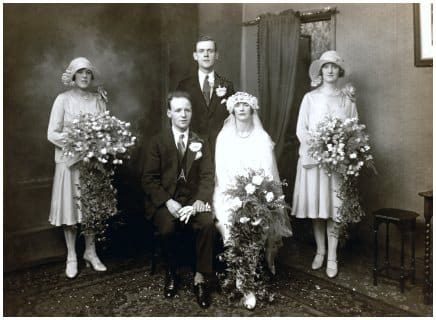
This wedding photo of the groom Thomas Paton and the bride Lucy Flemmings, was taken on Sept 1, 1928. James, brother of the groom was the best man, and is seen standing behind the couple. This delightful 1920s wedding group photo was another picture which Kathleen Paton sent to me. I have previously shown several of her forbears in wedding pages on the site.
Both bridesmaids have abundant sprays, with generous trails of leaves; these are not the tiny posies displayed by bridesmaids of other eras. From the way the women and men are dressed, to the style of their bouquets, even the interior scene, all features have a distinctly British look.
The scenic cloudy background, to the left, suggests a setting in a photographer's studio, or possibly a hotel lounge.
Dating old photos is hard for the beginner new to genealogy, but using the usual principles of comparing known dated photos against undated photos to find similarities, it is possible to draw some conclusions that can at least give you a date to within 5 years.
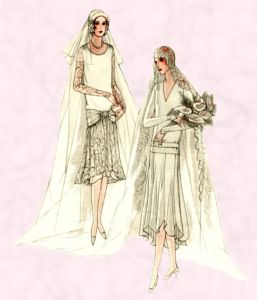
For 1928, the general fashion line for brides was the short dress. But not as short as in the period 1925-27. Hemlines had already reached maximum shortness for the twenties and now skirt lengths began to drop again. In every wedding photograph on this 1928 page the knees of the bride are respectably well covered with skirt fabric.
By 1928 hemlines settled on, or below the knee. Skirts had cross cut or circular fullness and often indistinct wavering hemlines. Bridal veils were still cloche style, but now quite long flowing into trains. Changes were being introduced with hair bands and tiara like elevation elements.
left - McCall's bridal patterns for 1928. Note the appearance of the 'calla lily' spray in the drawing. This was a big trend in floral bouquet fashions of the 1930s, and most useful in dating old wedding photos.
The dresses here have the straight tubular bodice silhouette, which was also popular for day dresses of 1928. The bridesmaids above wear skirts which are cut on the cross-grain of the fabric, a fashion most popular after 1926 when flip, flare and swing hit the hemline.
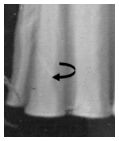
Only skirts cut on the true bias will show this smooth easy fluting so perfectly. One aspect of bias cut garments, especially of skirts, is that once a certain length is required, the skirt has to be pieced together. Notice the seam line shown in the small image right and which illustrates a pieced bias cut fabric.
1920s Bridesmaids Hats
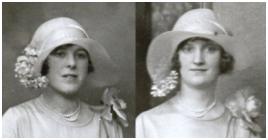
The hats that the bridesmaids are wearing in the photographs are also showing some of the side-swept brims that became smaller, and even more popular, in the thirties. This hat style is sign of a late twenties, or early thirties wedding photograph.
The floppy asymmetry of the hat is suggestive of the period 1927-1932 in particular. The wide brim hat is seen in 1926 images, but it seems to me that by 1927 that the hat style has begun to distinctly veer to one side, with upturn, and often is weighted with decoration.
1928 Bridal Veil Headdresses
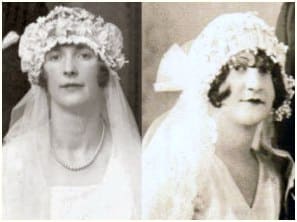
Here we have 1928 vintage photographs of two different brides. On the left is an enlargement of Lucy Flemmings, featured above. On the right is an unknown, probably American bride, who we wish to date.
The veils of these two brides mostly follow the decorated mob cap, or cloche veil style. The front of the mob caps appear shirred. The small amount of fanned tulle at the back of the right headdress, is similar to styling elements found in the veils of 1922, and seems to have mostly been an American fashion.
What makes these headdresses look different to earlier veil arrangements is actually the fuller, bouncier, hair beneath. All of the women on this page are showing much softer hairstyles. By 1928 soft waves had made a comeback, and consequently, the severity of the Eton crop haircut began to decline.
The veil similarities suggest that this unknown bride was married in the late twenties, probably 1928. When proposing the 1928 date, I also took into account other bridal gown factors, such as the V-neckline, the feather/fur hemline, and her footwear.
Lucy (1928) far left above, is wearing a V-neckline, but it has a modesty filler. The unknown photo is probably not later than 1928, because by 1929, bride's skirts were often longer.
Bridal Bouquets 1928
Compact bridal bouquets are more often seen in USA old photos. In theses examples, the UK bride's bouquet spray is fulsome with masses of foliage, yet relatively few flowers.
The flowers are not particularly rare, and the bouquet almost appears disorganised.
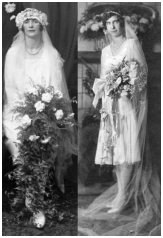
Hot Tip - British 1920s wedding bouquets often had long trails of foliage greenery compared to USA bouquets.
International florists note that long trains of foliage in bouquets are preserved in the style of European florists to this day. American bridal bouquets mostly show some greenery, but are more likely to be bulked up with an abundance of trailing ribbons, bows and attached pieces, which add volume and lightness.
Esther (Morrill) Reynolds 1928 Wedding Dress
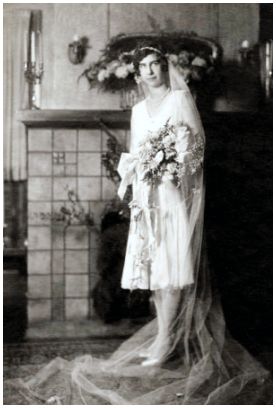
This vintage wedding photograph left, was taken in the USA in 1928.
The photograph is known to be of Esther (Morrill) Reynolds, she was married in Oakland, CA. on August 30, 1928; the photo was kindly provided by her descendant Anne Scott. The photo was probably taken at the parental house before the bride departed for the wedding ceremony.
Whilst today we might consider being photographed by a tiled fireplace unattractive, it's important to remember this fireplace was probably the focal point of the room and was known as a 'modern' grate. It was a symbol of progress and of affluence in the new century.
Behind the fire grate itself would have been a system such as a Baxi Burner which heated water for the whole house. This was modern and comparatively clean compared to using an old copper for boiling water. Though it probably would not have been in use on a summer's day.
This a USA wedding and Esther's bouquet has trailing ribbons instead of foliage. In keeping with the latest fashion styles, this wedding gown has a V-neckline, dropped hip waistline and long sleeves. Esther wears a fashionable flapper headband to hold her veil in place.
You have been reading an original independent article dating 1928 wedding photos by Pauline Weston Thomas at www.fashion-era.com ©
Undated Old Wedding Photos of 1920s
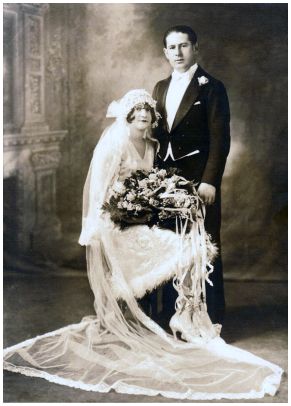
This brings me to two more photographs of unknown vintage, kindly sent by a collectors of old wedding photos.
Missaamie and Manaseri2007 each sell vintage items including wedding photos on EBay.
Note how in both images the volume of trailing ribbon in the bride's floral sprays implies that these were USA weddings, this would fit with the sources, as in this case both Missaamie and Manaseri2007 are USA based EBay sellers.
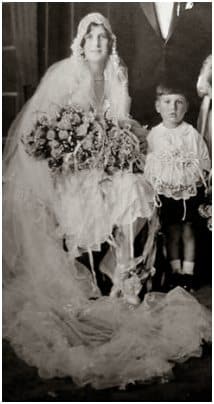
The length of both dresses, V-necklines, footwear and the headdress veils all bear a similarity to the 1928 photo at the top of the page. I would date both brides at about 1927-1929. Veils gained in length from 1927.
Fur/Feather Hem Wedding Dress 1928
Since the hemline of the first dress is covered in fur or feathers, this wedding photo was most likely a late autumn or winter wedding.
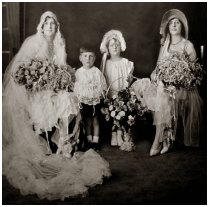
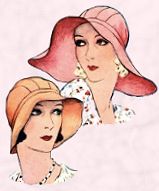
The skirt is richly embroidered. Probably this vintage photo was taken in a studio setting since you can clearly see that the background is like a painted stage backcloth and includes a fireplace in perspective.
I do believe this second photo above right and also near right, was taken about 1928-29. Although the dress has a scalloped hemline, it has a V-neckline and appears longer than mid-twenties styles.
Note too how the full photo shows a bridesmaid who has a late 1920s look. That asymmetric hat and the longer line skirt are clues to it being near 1929/30.
These two coloured sewing pattern hats are from 1932 and as such would have been lagging a little behind manufactured garments.

The bridesmaid dress does not look quite 1930s and the dress does not look as short as dresses of 1926/7.
Her scoop neckline dress has the softer slightly longer layered flutes of late twenties fashion styles. The gown also appears to be asymmetric in cut, which is shown by the way the skirt fabric sits over the knees in an irregular uneven fashion.
The headdress which the small flower girl wears, is also similar to adult bridesmaid headwear of 1931. Costume lovers will know that trends for adults often have their beginnings in styles worn earlier by children. Fashion history shows that fashion styles have a habit of working through the generations and through the sexes, although rarely all at once.
You have been reading an original independent '1928 wedding photograph' article by Pauline Weston Thomas at www.fashion-era.com ©
Celebrity Weddings in 1928 - (They were few!)
Boxer Gene Tunney married Mary 'Polly' Lauder in Italy. It was one of the most sensational love stories of the 1920s. She was a Carnegie heiress, and he was the boxer who beat Dempsey in the famous 'long count fight'.
The film 'The Wedding March' starring Fay Wray and Eric von Stroheim was released.
Interesting Facts and Events in 1928
- January 30 - The first radiotelephone connection between Netherlands and US.
- January 31 - Scotch tape was first marketed by the 3M Company.
- April - Madame Tussaud's bigger and better waxwork exhibition re-opened in London after a 3 year gap due to fire gutting the building in 1925.
- May 15 - Walt Disney's Mickey Mouse made his debut.
- June 17 - Amelia Earhart left Newfoundland to become the first woman passenger to fly Atlantic in a plane piloted by Wilmer Stultz.
- July 2 - British parliament accepts equality in female suffrage, as a result, all women over 21 gained the vote.
- February 8 - First transatlantic TV image received, Hartsdale, New York.
- July 3 - John Logie Baird made the first TV broadcast in London
- July 28 - Amsterdam Olympics Open
- July 30 - George Eastman first showed colour motion pictures in the USA.
- September 15 - Alexander Fleming discovered penicillin.
- November 10 - Emperor Hirohito ascended throne of Japan.
1928 section added 18 April 2008. Ref P691
